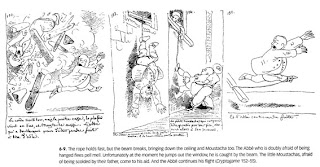 Father of the Comic Strip – Rodolphe Töpffer by David Kunzle, 207 pages, University Press of Mississippi, 2007, US$25 (paperback edition)
Father of the Comic Strip – Rodolphe Töpffer by David Kunzle, 207 pages, University Press of Mississippi, 2007, US$25 (paperback edition)First things first. The Swiss schoolmaster, writer and artist Rodolphe Töpffer (1799-1846) was not “the father of the comic strip”. You don’t have to think that comic strips began on the cave walls at Lascaux to realise that. They were already common in the early nineteenth century, as single-sheet prints. You can see an example by Thomas Rowlandson in an earlier post. The author of this volume, David Kunzle, professor of art history at the University of California, Los Angeles, even reproduces a French broadsheet comic strip version of Robinson Crusoe himself.
Töpffer’s innovation was to spread his stories out over multiple pages, with multiple panels to a page, and have them printed and bound in albums. Inside the book, Kunzle qualifies his title by referring to Töpffer as “the father of the modern comic strip”. He might more accurately be called “father of the comic book”.
He was not only an innovator, he inspired others. The first publishing imprint devoted to comic books, Albums Jabot, was set up in France to publish pirated editions of Töpffer’s works, going on to commission new comics from Cham (Amédée de Noé) and Gustave Doré. He inspired comic strips by such luminaries as Edward Lear, Henri de Toulouse-Lautrec and William Makepeace Thackeray – examples of which are reproduced by Kunzle.
Töpffer’s comic albums, which he began to publish in 1833, were picaresque slapstick farces with light satirical elements. The one thing that anyone who has heard of Töpffer knows is that Goethe was a fan. Kunzle explains that this was because Goethe greatly preferred Töpffer’s mild, humorous approach to the scabrous bile of the English school of caricaturists. Töpffer’s artwork was based on simple outline drawings, which were designed to allow the reader to grasp the salient points quickly and to move swiftly on to the next panel. This was a contrast to Töpffer’s own hero, William Hogarth: every engraving in one of Hogarth’s sequences demands slow painstaking attention to its detail.

Töpffer sometimes attributed his style to a carefully considered theory of aesthetics, and sometimes to his poor eyesight. To my own poor eyes, he looks like someone making the very best of limited talent and technical skill in drawing, much as Jules Feiffer would do in the 20th century. Kunzle, however, sees a good deal of sophistication in Töpffer’s draughtsmanship and he has John Ruskin on his side (“he can do more with fewer lines than any draughtsman known to me”), so who am I to argue?
Certainly, Töpffer sometimes pulls off some starting effects with the grammar of comics. In the sequence below, he cuts rapidly between Mr Jolibois, caged in the belief that he is a wild beast, and the Professor who is studying him. Remember, Töpffer produced this strip eight decades before Eisenstein revolutionised film editing.

The publishers describe David Kunzle’s book as the first full-length study of Töpffer in English. It is a companion volume to a complete edition of Töpffer’s comic strips in translation, edited by Kunzle.
The study opens in a rather daunting manner, when, after the briefest of introductions, it plunges into an analysis of contemporary political themes in Töpffer’s comics, which assumes a degree of familiarity with the strips which I did not have. As the next chapter is also thematic – a discussion of Goethe’s opinions of Töpffer – I began to wonder if this had been planned as a bumper edition of some new Journal of Töpffer Studies. Fortunately the next few chapters discuss the comics themselves in a straightforward chronological way, before backtracking to consider Töpffer’s prose works, and then looking at his legacy.
Kunzle is particularly good on the publication and reception of Töpffer’s work. Already, there were French critics who would praise his prose works and draw a veil over his comics. Kunzle also brings out the extent to which Töpffer’s innovations were dependent on advances in print technology: new developments in lithography made it a lot easier to reproduce art the same way round as the artist drew it (woodcuts and etchings generally reversed the original drawing). Without this, it would have been much harder to integrate handwriting and drawing in the way that he did. You could almost infer that comic books were just waiting to be allowed loose in the world when the printing presses allowed.
I found the chapter about Töpffer’s influence on comics in France, Britain, America and Germany particularly interesting. I suspect that this may have reworked material from Kunzle’s earlier, two-volume History of the Comic Strip, but since I have never seen that long out-of-print work on sale for less than £300 a volume, I am not complaining.
The book is heavily illustrated throughout, with extracts from Töpffer’s own works as well as artists who influenced him (including Daumier and Cruikshank) and artists whom he influenced.
Well worth reading, if you are interested in comics history. If nothing else, it will equip you for lots of pretentious name-dropping.
No comments:
Post a Comment